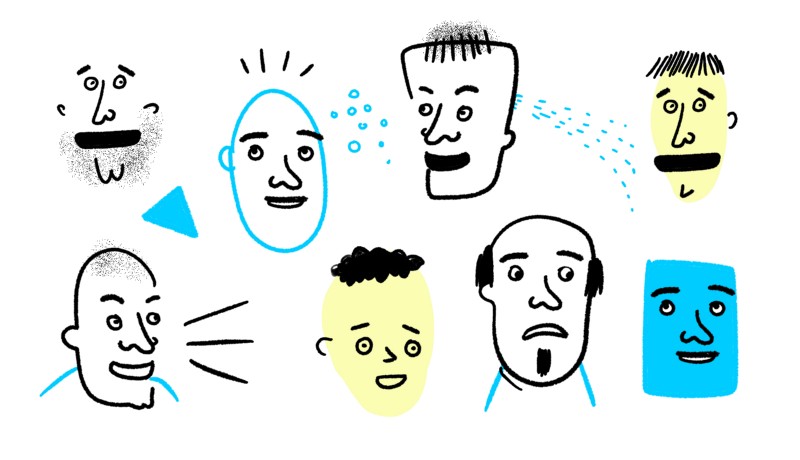How designers are deceiving themselves
- Transfer
Hi, Habr! I present to your attention the translation of a small article by designers . Is it really so? Or are people no longer afraid of sharp corners and not trying to be nice and tactful?
About the author: Fabrizio Teixeira, art director of Work & Co, founder of UX Collective.

What we say:
"Let's take a fresh look at this on Monday morning."
What do we mean:
“Dude, it's Friday night. I'm done. You think so too. But we will not admit it. ”
What is the result:
"Monday morning" never happens. In most cases, even for the better.
What we say: “I like your train of thought, but I’ve been thinking about whether we should consider it ...”
What we mean:
“I don’t like your train of thought”.
What is the result:
Designers, who initially chose the wrong path, never point out their mistakes. No one says directly what is wrong. A whole generation of designers has grown up who believe that they are always right. Receiving a negative review afterwards, they sincerely do not understand what the matter is.
What we are saying:
“What you see now is just the insights made in the last couple of weeks. Of course, we continue to work. "
What we mean:
“We did not have the courage to make any decisions and / or clearly state them on the slide. And although we had two weeks, we did not strain ourselves to complete what we started. So let's avoid controversial points of view in the presentation. We do not want to spoil the relationship, right? ”
What is the result:
Delayed release for two weeks.
What we say:
"We conducted several informal test sessions for users here in the office and found that it is difficult for people to identify what is shown on the screen."
What we mean:
“I showed it to the guy who sits next to me. He didn't like it. ”
What is the result:
No-chego.
What we say:
“I heard you. We will definitely consider your proposal as soon as we improve the design. ”
What do we mean:
“I do not like this idea, I'm sorry. I pretend to try to accommodate your wishes, and then come up with some excuse why it didn’t work. ”
What is the result:
Not a single pixel was harmed.

And now for garlic: reticence helps to avoid conflict situations and postpone unpleasant conversation, but in the long run they have a negative effect. Design is a team game, and trust and integrity are important for a good team. The disagreement actually has a creative effect: a joint solution to the conflict will only unite you.
So please, less euphemisms, more maturity.
About the author: Fabrizio Teixeira, art director of Work & Co, founder of UX Collective.

What we say:
"Let's take a fresh look at this on Monday morning."
What do we mean:
“Dude, it's Friday night. I'm done. You think so too. But we will not admit it. ”
What is the result:
"Monday morning" never happens. In most cases, even for the better.
What we say: “I like your train of thought, but I’ve been thinking about whether we should consider it ...”
What we mean:
“I don’t like your train of thought”.
What is the result:
Designers, who initially chose the wrong path, never point out their mistakes. No one says directly what is wrong. A whole generation of designers has grown up who believe that they are always right. Receiving a negative review afterwards, they sincerely do not understand what the matter is.
What we are saying:
“What you see now is just the insights made in the last couple of weeks. Of course, we continue to work. "
What we mean:
“We did not have the courage to make any decisions and / or clearly state them on the slide. And although we had two weeks, we did not strain ourselves to complete what we started. So let's avoid controversial points of view in the presentation. We do not want to spoil the relationship, right? ”
What is the result:
Delayed release for two weeks.
What we say:
"We conducted several informal test sessions for users here in the office and found that it is difficult for people to identify what is shown on the screen."
What we mean:
“I showed it to the guy who sits next to me. He didn't like it. ”
What is the result:
No-chego.
What we say:
“I heard you. We will definitely consider your proposal as soon as we improve the design. ”
What do we mean:
“I do not like this idea, I'm sorry. I pretend to try to accommodate your wishes, and then come up with some excuse why it didn’t work. ”
What is the result:
Not a single pixel was harmed.

And now for garlic: reticence helps to avoid conflict situations and postpone unpleasant conversation, but in the long run they have a negative effect. Design is a team game, and trust and integrity are important for a good team. The disagreement actually has a creative effect: a joint solution to the conflict will only unite you.
So please, less euphemisms, more maturity.
